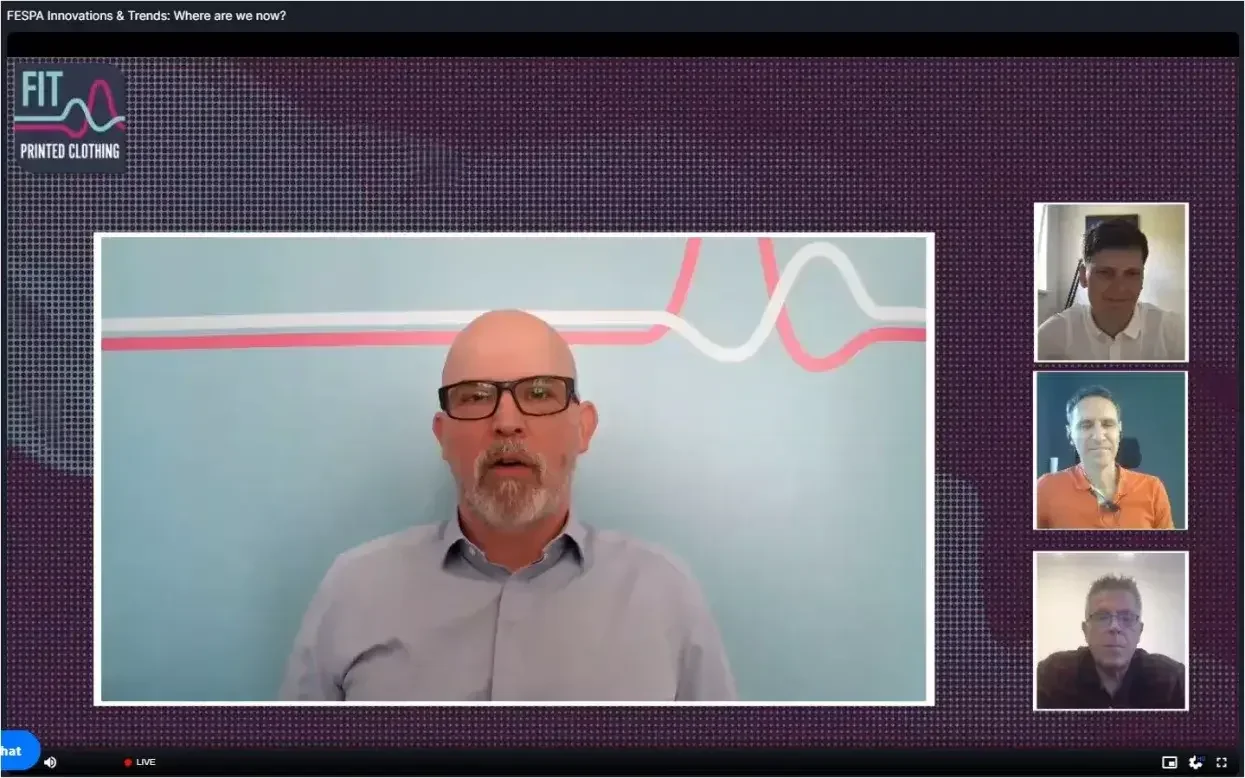
In our recent FESPA Innovations & Trends (FIT) virtual event we brought together three printers from across the world to discuss the latest trends in garment decoration and the future of the sector.
The host: Graeme Richardson-Locke: Head of Associations and Technical Lead, FESPA. With 35 years’ experience in the industry, Graeme began as an apprentice and progressed through several directorships before joining FESPA in his current role. He is also a member of the Academy of Screen and Digital Printing Technologies.
The experts: Samir Sadikoglu, Owner and General Manager of BirSifir Tekstil AS in Turkey. After 24 years with the family business, ETF Tekstil, Samir’s new venture is a contract screen printer for sportswear and fashion manufacturers. He also owns the Grit3.com e-commerce brand.
Raitis Purins, Head of Marketing at Printful, Latvia, an on-demand fulfilment specialist offering e-commerce warehousing, custom print, embroidery and product drop-shipping for online retailers.
Mark Gervais, Director of Screen Print at Ningbo Shenzhou Knitting Company, Shenzhou, China. Mark has worked in screen printing since 1977 and has managed Ningbo’s huge capacity (up to 850,000 pieces a day) since 2009. He is also a member of the Academy of Screen and Digital Printing Technologies.
The rise in consumer demand for sustainable products increases the need for organic, Fairtrade and ethically-produced blank garments to print. Are your suppliers able to offer the volumes, sizes, and colour energies that you require to transform your offers?
Raitis: That’s a great question because when it comes to sustainability one of the questions is, how are the products made? I remember when I joined Printful five years ago, we discontinued some of the eco products, as we called them, because there were some stock issues, and now the trend is coming back. More and more people are thinking about building an eco-brand, and one of those factors is also the product.
Honestly, the main thing is the stock availability. I know normal t-shirt stock levels are much better. Because we produce almost a million items every month, as soon as we add a product, we need a sustainable stock level so that our suppliers can provide them, and I believe that’s the main issue. I’m not even talking about the colours; this is generally about the volume.
I believe in the future it’s going to change, but maybe we need to be more vertically integrated — to start producing ourselves. That would be interesting.
Samir: I see that “Generation Z” is much more interested in sustainability than we were. We started sustainability programs 20 years ago, with a certain percentage of organic cotton in our garments, but none of us was willing to pay an extra amount for the sustainable goals. Today, I see that shift, and the latest McKinsey report shows that Generation Z is much more aware of sustainability, and they want to make an impact, and they would pay extra to achieve this.
Yes, availability is important. We work with our partners to source more than 2 million pieces a month, and all of that is sustainable. By that I mean it answers several questions. Is the cotton sustainable? Is the dye of the fabric sustainable? Is the print sustainable? There are a lot of different options on the market. The Better Cotton Initiative is one option. Organic cotton is another. Recycling is another. Having a percentage of recycled cotton in the mixture is another option.
There are a lot of opportunities which we can offer. Plus, I want to emphasise one thing. The fabric dyeing is the most critical part here, and that’s the most polluted industry in the world after the oil industry. I’m very sensitive about this. I’m working with guys who have a patent, and the dyes that they’re producing are 100% organic. So dyeing is another thing to ask about and to try to find what’s the best available option for our needs.
Mark: Sustainability is the number one topic at all brand levels right now. As Samir pointed out, it means a lot of different things to different people. I’m always the guy asking, ‘how do we measure that?’ ‘How are we measuring sustainability?’ ‘Is there an index?’ We can talk about the garment, and here I’m just echoing what Samir already talked about. There’s BCI. There is recycled cotton. There’s recycled polyester. There’s making T-shirts from water bottles. And then you start to go, as he pointed out, into the dye processes in the wastewater, the waste stream.
It used to be a couple of times a year, and now we’re being asked every month, ‘what do you have for sustainable inks?’ Now there are bio-derived inks. And biodegradable inks. There are black inks that are made from algae. There’s a lot more coming to the market. Once again, to echo Samir, even my son reminds me about how we need to reuse something, or how we don’t need to throw that away. He’s telling his old man because it’s his planet, he’s going to be the one running around. These are the young kids that are concerned with that. It’s a hot topic. It’s almost every day now, which is why we have a whole department set up for sustainability.
You can see the whole conversations here, and for more information on the first day of the FESPA Innovations and Trends Printed Clothing event, visit here. :
Discover the latest innovations in garmnet printing at the Global Print Expo 2021, Europe’s leading exhibition for screen and digital wide format print, textile printing and signage. Discover the latest products, network with like-minded individuals and explore new business opportunites. Register now and use promo code FESH101 to receive a discount of 30 euros.